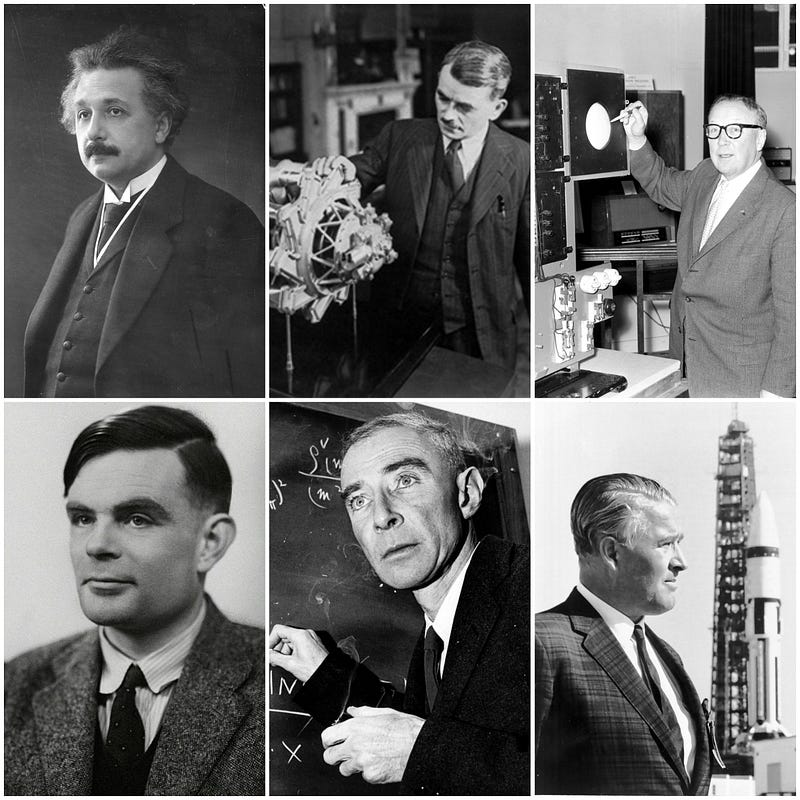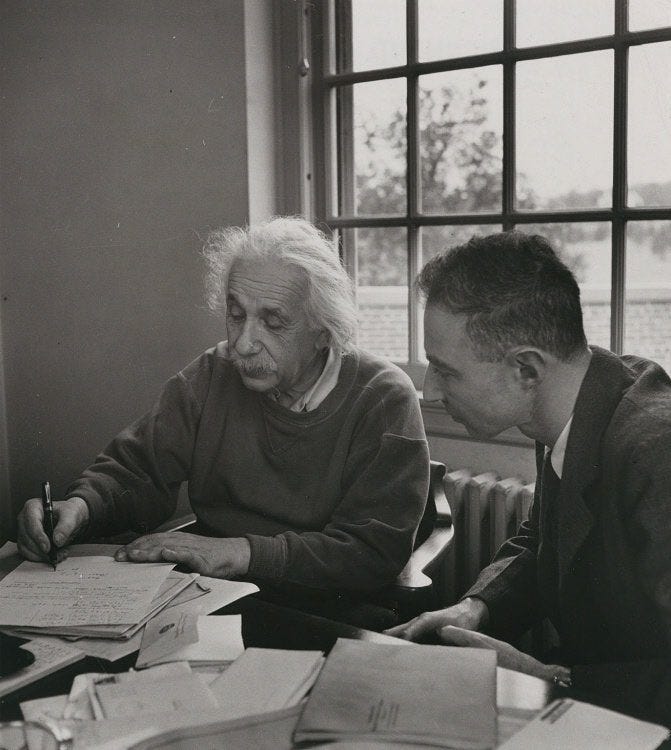8 Noteworthy Physicists Who Played Roles in Conflicts
Written on
Chapter 1: The Duality of Science and Warfare
In the words of Richard Feynman, “Scientific knowledge is an enabling power to do either good or bad — but it does not carry instructions on how to use it.” This profound statement highlights the dual nature of scientific advancement, which can be wielded for both constructive and destructive purposes.

Top [L-R]: A. Einstein, Frank Whittle, and Robert Watson-Watt. Bottom [L-R]: Alan Turing, J. Robert Oppenheimer, and Werner Von Braun. Images from respective archives and owners.
Section 1.1: Albert Einstein's Legacy
Albert Einstein stands out as one of the most brilliant minds in human history, with significant contributions to modern physics. His groundbreaking discoveries have led to numerous practical applications we enjoy today.
As the Nazi regime rose in Germany, Einstein was forced to flee due to discriminatory laws against Jews. Amidst a global arms race, concerns about Germany's potential development of nuclear weapons prompted Einstein to sign a crucial letter. This letter played a pivotal role in persuading President Roosevelt to embark on the Manhattan Project.
Section 1.2: Leonardo da Vinci's Ingenious Mind
Leonardo da Vinci was a remarkable polymath, renowned for his creativity and innovative thinking. It is said that he rarely slept, constantly occupied with new ideas and inventions. While he is primarily celebrated as a painter, da Vinci was also a self-educated engineer, designing various military machines for the Duke of Milan, including a multi-gun machine and a colossal crossbow.
Subsection 1.2.1: J. Robert Oppenheimer's Leadership
Robert Oppenheimer, a prominent theoretical physicist, was appointed to oversee one of the most significant projects in history—the Manhattan Project. Initially, the project was based on theoretical nuclear weapon concepts, with many scientists believing practical implementation would take much longer. However, Oppenheimer successfully led the team at Los Alamos, culminating in the bombings of Hiroshima and Nagasaki, which effectively concluded the war.

Section 1.3: Robert Watson-Watt's Innovations
During World War II, Robert Watson-Watt worked with the British Air Ministry, developing a radio-based system capable of detecting enemy aircraft. His contributions were crucial in bolstering Britain's wartime efforts.
Section 1.4: Frank Whittle's Aviation Breakthroughs
Frank Whittle, a cadet in the Royal Air Force in 1922, pioneered the concept of the turbojet engine. His vision materialized during World War II with the introduction of the Gloster Meteor, the first British jet fighter, in 1944.
Section 1.5: Alan Turing's Codebreaking Genius
Alan Turing was a leading mathematician during World War II, working in the British government's cryptography unit at Bletchley Park. His pivotal role in decoding the German Enigma Code not only saved countless lives but also significantly shortened the war.
Section 1.6: Werner von Braun's Rocketry Achievements
Werner von Braun designed long-range rockets for Germany during World War II, with his most notable creation being the V2 rocket. After the war, he relocated to the United States, where he played a key role in advancing rocketry programs.
Chapter 2: A Deeper Look into the Lives of These Physicists
The first video titled "All Physicists In Oppenheimer - Their Scientific Contributions" delves into the remarkable achievements of physicists involved in the Manhattan Project and their lasting impact on science and warfare.
The second video, "The Trials of J. Robert Oppenheimer | Full Documentary | AMERICAN EXPERIENCE | PBS," provides an in-depth look at Oppenheimer's complex legacy and the moral dilemmas faced by scientists during the war.
Thank you for taking the time to read this piece. If you found it engaging, please show your support by clicking the clap icon. For those interested in further supporting my work, consider becoming a Medium member or buying me a coffee. Stay tuned for more insightful stories!